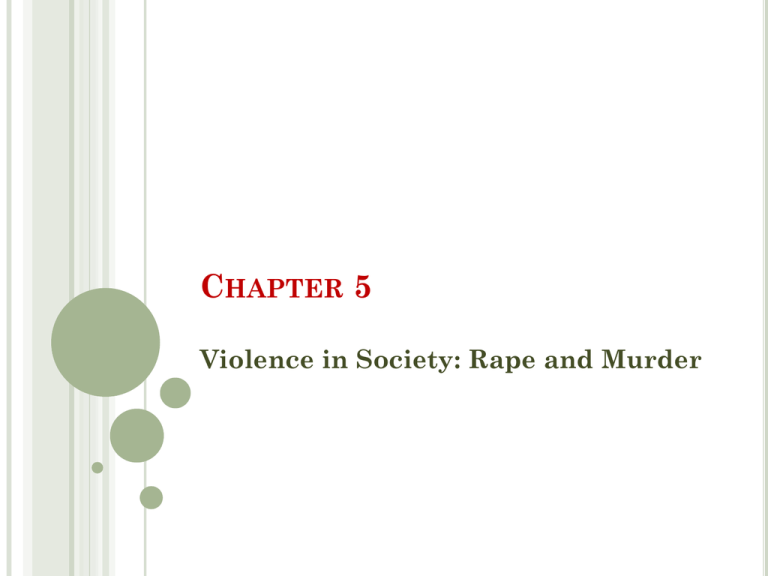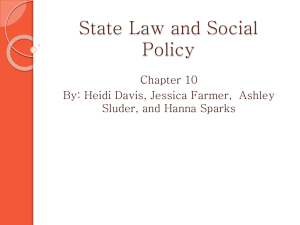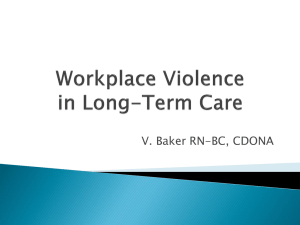
CHAPTER 5
Violence in Society: Rape and Murder
THE PROBLEM IN SOCIOLOGICAL
PERSPECTIVE
Violence:
the use of force to injure people or to
destroy their property
Types
of Violence
Situational group violence: unplanned and spontaneous
Organized group violence: planned but unauthorized
Institutionalized group violence: violence carried out by
agents of the government
Anti-institutional violence: violence directed against the
government in violation of the law
WHAT MAKES VIOLENCE A SOCIAL
PROBLEM?
The
amount of violence (an objective condition)
does not make violence a social problem.
Subjective concerns about violence make it a social
problem.
When deciding whether a particular violent
behavior is a problem, people ask the following
questions:
What do the actors intend by their action?
Does violence conform to, or violate, social norms and
values?
Does the violence support or threaten the social order?
Is the violent committed by or against the government?
Rate Of Violence
•Number of violent crimes for each 100,000
Americans
•Always be wary of crime statistics
Figure 5.3 – How Countries Compare
in Rape and Murder
LOOKING AT THE PROBLEM
THEORETICALLY
Biological Explanations
Cesare Lombroso (1835–1909)
Konrad Lorenz (1966)
Claimed that evolution was the key to explaining
violence
Psychologist John Dollard
Atavistic: biological throwbacks to earlier period when
humanity was violent and primitive
Frustration–Aggression Theory of Violence
Problems with biological approach
Psychological Theories
Behavior Modification – Operant Conditioning
Modeling
Stress that if some behavior is rewarded (“reinforced”), that
behavior will occur again
Copying another person’s behavior
Problems with psychological approach
Sociological
approach to understanding
violence
Sociologists stress environmental causes
Examine how social life shapes and encourages—or
discourages—violence
FUNCTIONALISM
Emile Durkheim: asking the sociological
question…functions of crime?
Crimes affirm a society’s norms and values
Recognizing crime = line between right and wrong
Brings people together
Social change
Violence/crime is normal
Anomie: feelings of disconnectedness and anxiety
Robert Merton: Strain Theory
Used Durkheim’s anomie to explain crime in
the U.S.
Success becomes a cultural goal
Cultural Means: ways to reach cultural goal
Strain (or frustration and anxiety) that comes
from limited means may motivate some to
commit crime
Strain Theory explains why high crime rates
exist among poor minorities—they experience
fewer means to achieve success
Gottfredson and Hirschi: Control Theory
Control Theory: places root cause of committing illegal
acts on a lack of self-control
Causes of low self-control are negative and tend to show
themselves in the absence of nurture, discipline, or
training
Ineffective child-rearing practices are the major cause of
low self control
Internal/External controls
Minimum requirements of effective child rearing:
Adequate monitoring of the child’s behavior
Recognition of deviant behavior when it occurs
Fair and consistent punishment of such behavior when it occurs
SYMBOLIC INTERACTIONISM
Edwin Sutherland: Differential Association
People learn violence by interacting with other violent
individuals.
People learn techniques, attitudes, motives, drives, and
rationalizations for violence.
Excess of definitions
Most significant interactions in which people learn
violence take place earliest in life, are the most frequent,
endure the longest, and are the most emotional or
meaningful.
Mechanisms for learning violence are the same as those
used to learn nonviolence.
Marvin
Subcultural Theory
People who grow up in subculture that approves
violent behavior have higher chance of becoming
violent
Fitting
Wolfgang: Subcultures of Violence
the theories together
Theories complement one another well
Subcultural theory stresses that violence is
woven into the life of some groups.
Differential association explains how people learn
that violence is a suitable response from other
violent people.
CONFLICT THEORY
Violence
is inherent in society
Social classes find themselves competing over limited
resources.
Essential division is between owners of production and
workers.
Situation is particularly tense for working-class males.
Look beneath the surface and realize that capitalist
class is actually more violent than the working class.
Form of violence that distinguishes workers from
capitalists
RESEARCH FINDINGS
Two most serious forms of physical violence: rape
and murder
Forcible
Rape: form of assault where one forces
another to have any type of sexual relations
against that person’s will
Statutory Rape: sexual intercourse between an
adult and a minor
RAPE
Rape
perceived as social rather than personal
problem
Feminists: traditional definition of rape places
blame on the victim, not perpetrator
Feminist revision removed burden of guilt from victim
and placed on perpetrator
Rape is an outcome of patriarchy: control by men of a
disproportionately large share of power
Legal
definitions of rape changed and replaced
with Criminal Sexual Assault
THE SOCIAL PATTERNS OF RAPE
FBI: 89,000 American women are forcibly raped
each year
Predictable social patterns
The National Crime Victimization Survey
Acquaintanceship; place; time; season; age; income;
race–ethnicity; geography; region; weapon
Sociologists conclude that rape is not the act of a few
sick men, but, rather, is intimately linked to our
patriarchal culture.
Injury, rape, and resistance
Woman who resists her attacker less likely to be
raped, but more likely to be injured
PROFILING THE RAPIST
10 profiles of rapists based on confessions:
Woman Hater
Sadist
Generally Violence-prone
Revenge
Political
Soldier Rape: rape committed by a soldier on a
country’s inhabitants during wartime
Walter Mitty rapist
Opportunist
Date Rapists, also called Acquaintance Rapists
Recreational Rapist
Husband rapist attacks his own wife
REACTIONS TO RAPE
The trauma of rape
Dealing with their trauma
Expressive or Controlled
Dealing with the legal system
Does not end with the physical attack
Police departments have grown more sensitive to
rape victims
In only 40% of reported rapes is someone arrested
“Legal Rape”
Homosexual rape
MURDER
The
Least likely to be committed by a stranger
Perpetrators share characteristics of social class, sex, age,
and race–ethnicity with rapists
Men as killers identify guns as masculine
Most dangerous time of the week is Saturday night
social patterns of murder
Saturday Night Specials refer to any inexpensive handgun
U.S. murder rates have plunged 43%
EXPLAINING SOCIAL PATTERNS
Acquaintanceship: most killed by someone they know
Poverty: Conflict Theory—people in poverty may be
striking out at one another instead of at their oppressors.
Functionalists adopt both strain theory and control
theory.
The meaning behind murder: Symbolic Interaction—in
some poor subcultures criminal behavior enhances a
person’s reputation.
Social classes also resolve disputes differently.
Killing as a manly act: the measure of one’s capacity as
a man
Women are less likely to be socialized into violence
Racial–ethnic differences
African Americans kill at a higher rate than other
races.
More likely to be poor
Subculture identifies masculinity with the willingness to defend
oneself aggressively
Interracial patterns: Functionalists stress a connection
between race–ethnicity and money
Mass
Murder: killing of four or more people in a
single episode
Serial Murder: killing of several people in three or
more separate events
Four
social policies for prevention of violence:
Programs that teach equality
Social policies that increase the likelihood that rapists
will be punished
Support research to determine how our culture creates a
climate of violence
Gun control
THE FUTURE OF THE PROBLEM
Conflict theory indicates that tensions will remain in our
society
Functionalist perspective explains that violence is
functional enough to be perpetuated and maintained
Symbolic interactionist perspective focuses on violence as a
cultural symbol used to resolve conflict
Sociological perspective on violence essential to
understanding our present and future state
Understanding of the social basis of violence can be used to
implement beneficial solutions
THE MASS MEDIA AND VIOLENCE
There is no single cause of violence in US society
Most researchers agree that mass media play a part in
the problem
Today’s young people live in a world dominated by the
mass media, and violence is an ever-growing part of that
culture
Most analysts agree that violence in the media affects
everyone by desensitizing people to violence
POVERTY AND VIOLENCE
Poverty itself as a form of violence that US society
inflicts on people
Low income people are highly represented as both
victims and offenders of violent crimes
Most violent crime in poor neighborhoods is a work of a
small number of repeat offenders
YOUTH GANGS AND VIOLENCE
Youth gangs can be:
Nonviolent groups
Those who sometimes clash over turf
All-out criminal organizations
Typical violent gang members:
Come from poor, single-parent families
Are from neighborhoods characterized by high crime
rates, drug abuse, and limited job opportunities
DRUGS AND VIOLENCE
Drugs contribute to violence by distorting
judgment and reducing inhibitions
Addictions can cause cravings so strong that the
search for the next high may lead some people to
violence and sometimes even to neglecting or
abusing their children










